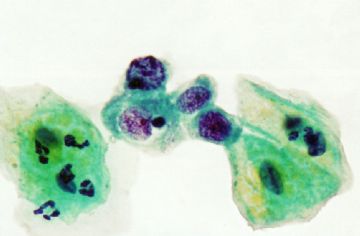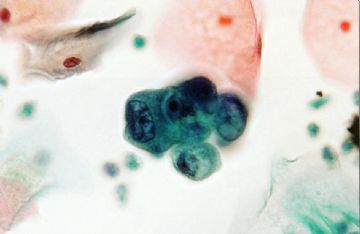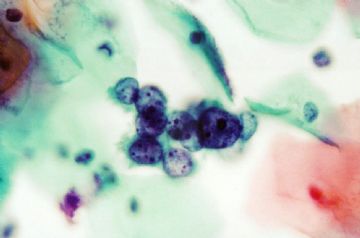| 图片: | |
|---|---|
| 名称: | |
| 描述: | |
- 怀孕相关改变--你知道多少???
资料来源于书本,我翻译的。自认为总结的很好,我们平时也容易忽略这些改变,希望感兴趣的同仁可以借鉴。
1、A-S反应
A-S反应是促孕效应引起的子宫颈管内或子宫内膜的良性反应性病变,通常和怀孕有关,也可见于老年妇女的孕激素治疗。细胞的变化归因于E、P水平的增高,表现为胞核的多体性,但并无非整倍体的证据。这种变化常常是局灶的并且可随激素水平的回落而复原消失,巴氏涂片中的特征性变化是单个或簇状细胞表现有:细胞和胞核增大、核仁明显、孤立的大的奇异型细胞、充满变数的变性性改变。(图1-5)
一个特征性改变是出现胞质内空泡(图5)。
这些特征易和腺癌混淆,尤其是透明细胞癌(图6)。
为了避免过度诊断,获得病史非常重要,另外要注意相关细胞明确的反应性改变以及有活力的决定性恶性细胞的缺乏。
-
本帖最后由 于 2009-11-10 15:06:00 编辑
Am J Clin Pathol. 2000 Nov;114 Suppl:S6-20.
Cytopathology of pregnancy-induced cell patterns in cervicovaginal smears.
Department of Pathology, Saiseikai Shiga Hospital, Imperial Gift Foundation, Ritto, Japan. kobayashi@v7.com
Considerable interest has been devoted to cytology in pregnancy, especially the morphologic changes that may cause problems in differential diagnosis. It is surprising that the published discussion of the cytologic appearance of smears from pregnant women has been so limited. This review emphasizes that retained trophoblastic tissue may be a source of highly atypical appearing cells in the cervicovaginal cytology obtained under various clinical conditions. Distinguishing between Arias-Stella cells and cells of glandular abnormalities can be problematic, since the morphologic characterization of the former is poor. This review also emphasizes that a full awareness of the morphology of pregnancy as well as of the patient's clinical history are needed for greater precision in diagnosing cell patterns as pregnancy-related and not malignant.
PMID: 11996172 [PubMed - indexed for MEDLINE]

- 掌心0164
Acta Cytol. 2001 May-Jun;45(3):294-9.
Significance of AGUS Pap smears in pregnant and postpartum women.
Chhieng DC, Elgert P, Cangiarella JF, Cohen JM.
Department of Pathology, New York University Medical Center, New York, New York, USA. dchhieng@path.uab.edu
OBJECTIVE: To study the clinical significance of atypical glandular cells of undertermined significance (AGUS) in pregnant and postpartum women. STUDY DESIGN: We evaluated 35 women who were pregnant (30) or within three months postpartum (5) and had a cytologic diagnosis of AGUS. Twenty-seven (77%) patients had follow-up: 17 (63%) patients underwent colposcopic examination and biopsy, and 10 (37%) had repeat Pap smears. Eight patients were lost to follow-up. RESULTS: Five (29.4%) patients had a squamous intraepithelial lesion (SIL), including three high grade and two low grade, on subsequent biopsy. The remaining (70.6%) patients had benign pathology, which included 5 chronic cervicitis, 4 endocervical and/or endometrial polyps, 2 Arias-Stella reaction and 1 microglandular hyperplasia. Among the patients with repeat Pap smears, two had persistent AGUS/atypical squamous cells of undetermined significance, the remaining cases were within normal limits. CONCLUSION: Pregnancy-related changes may present with glandular atypia. In addition, about one-third of pregnant and postpartum women with a diagnosis of AGUS had SIL on subsequent biopsy; that rate is similar to that in nonpregnant women. Therefore, pregnant women with a cytologic diagnosis of AGUS should be followed closely.
PMID: 11393057 [PubMed - indexed for MEDLINE]

- 掌心0164
Diagn Cytopathol. 1996 Jun;14(4):349-55.
"Arias-Stella reaction"-like changes in endocervical glandular epithelium in cervical smears during pregnancy and postpartum states--a potential diagnostic pitfall.
Division of Cytopathology, Henry Ford Hospital, Detroit, MI 48202, USA.
A wide spectrum of histologic changes has been described throughout the female genital tract during pregnancy and in the postpartum period. Of these, the endometrial glandular changes referred to as the Arias-Stella reaction have classically been a diagnostic pitfall in histologic sections. Pregnancy-related changes are also reflected in cytologic material obtained from the cervix and vagina. Both glandular and stromal alterations may be seen. The changes involving endocervical glandular epithelium are often alarming enough to cause diagnostic difficulties, especially when the history of pregnancy is not provided. We report 13 cases where marked glandular changes led to diagnostic misinterpretations. These were characterized by cyto- and karyomegaly, a high nuclear to cytoplasmic ratio, round to oval nuclei with smudgy chromatin imparting a ground glass appearance, frequent intranuclear inclusions, and vacuolated to dense variable cytoplasm. The cytologic diagnoses ranged from "glandular atypia" to "suspicious for adenocarcinoma." Follow-up was available in 11/13 cases. In 9/11 cases, subsequent cervical smears on multiple occasions were negative. Cervical biopsies and/or dilatation and curettage in 4/11 cases did not show significant glandular abnormalities. The glandular changes encountered in cytologic material were similar to those described histologically in the Arias-Stella reaction involving the cervix. This similarity and the fact that these changes disappeared upon termination of the pregnancy favors the presumption that they represent the Arias-Stella reaction. Awareness of these changes during pregnancy and postpartum may prevent interpretive errors and unnecessary surgical procedures.

- 掌心0164
Acta Cytol. 1995 Sep-Oct;39(5):905-8.
Spectrum of cytologic changes in pregnancy. A review of 100 abnormal cervicovaginal smears, with emphasis on diagnostic pitfalls.
Department of Pathology, Wayne State University, Hutzel Hospital, Detroit, Michigan 48201, USA.
OBJECTIVE: To review pregnancy-related changes in cervicovaginal smears and to distinguish them from neoplasia and dysplasia. STUDY DESIGN: One hundred consecutive abnormal cervicovaginal smears from pregnant women obtained during 1992-1993 were reviewed. Corresponding biopsies that were available were also reviewed for cytologic correlation. RESULTS: Sixty-one percent of cases showed inflammation changes, 21% contained low grade squamous intraepithelial lesion, and 9% had high grade squamous intraepithelial lesion. Diagnostic problems were encountered with decidual cells, Arias-Stella reaction and trophoblastic cells. CONCLUSION: Both the clinician and pathologist must be aware of diagnostic pitfalls and false positive diagnoses in pregnancy. Hence, it is extremely important that the clinician notify the pathologist about the pregnancy status of the patient.
PMID: 7571968 [PubMed - indexed for MEDLINE]

- 掌心0164
-
amandabing 离线
- 帖子:117
- 粉蓝豆:22
- 经验:120
- 注册时间:2009-09-23
- 加关注 | 发消息
| 以下是引用掌心0164在2009-11-10 15:33:00的发言:
Am J Clin Pathol. 2000 Nov;114 Suppl:S6-20. Cytopathology of pregnancy-induced cell patterns in cervicovaginal smears.Department of Pathology, Saiseikai Shiga Hospital, Imperial Gift Foundation, Ritto, Japan. kobayashi@v7.com Considerable interest has been devoted to cytology in pregnancy, especially the morphologic changes that may cause problems in differential diagnosis. It is surprising that the published discussion of the cytologic appearance of smears from pregnant women has been so limited. This review emphasizes that retained trophoblastic tissue may be a source of highly atypical appearing cells in the cervicovaginal cytology obtained under various clinical conditions. Distinguishing between Arias-Stella cells and cells of glandular abnormalities can be problematic, since the morphologic characterization of the former is poor. This review also emphasizes that a full awareness of the morphology of pregnancy as well as of the patient's clinical history are needed for greater precision in diagnosing cell patterns as pregnancy-related and not malignant. PMID: 11996172 [PubMed - indexed for MEDLINE] |
这篇文章很好,是篇综述,很好地总结了孕期相关细胞改变,尤其欣赏作者对A-S反应的阐述及鉴别诊断的总结。
得高人相助,我找到了这篇英文文献的全文,有感兴趣的同仁可以站内留言,愿意与君共享!
-
digangport: 谢谢青青,我先留下邮箱:tlzj.hh@163.com,please send it to me soon.many thanks.2015-02-28 16:02















 谢谢大侠,学习了..
谢谢大侠,学习了.. 


 学习了
学习了 











